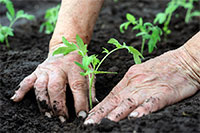Evolution of Organic Food
Organic foods as a movement first came to attention in the 1960s, amidst growing public concern over the use of pesticides and the state of agriculture. The chemical industry had become central to crop production, introducing a number of new products, some later revealed to be toxic enough to be banned entirely, as was the case with DDT in the 1970s. Some of these “legacy pollutants” (those that accumulate in food webs and are hard to get rid of) still haunt us today, showing up in the environment and wildlife decades later.
 At the time, using chemicals to ramp up agricultural production seemed like the right course – particularly given the increase in global food needs. This remains one of the arguments used to question organic production today; it is simply not efficient enough to feed the world.
At the time, using chemicals to ramp up agricultural production seemed like the right course – particularly given the increase in global food needs. This remains one of the arguments used to question organic production today; it is simply not efficient enough to feed the world.
However, organic production has been shown to provide comparable yields to farms that thrive on chemical application. Organic and a plentiful food supply are evidently not completely at odds.
Organic: What does it Really Mean?
Since the 1980s, a number of countries have added an organic certification requirement to their labelling laws. So, producers are required to meet standards and be certified organic before they can legally market and label their product as such. Overseen by private certification bodies, these government-backed labels provide a means to preserve the integrity of the organic label on grocery store shelves.
Organic production does not have one exact definition internationally, with individual governments outlining minimum requirements for their country. Efforts to harmonize these standards are underway, to help foster trade and reduce costs associated with the need for multiple certifications. Everything from soil health, to crop and pest management, to allowed and disallowed agricultural inputs is covered in the requirements of organic certification.
Some point out that organic certification may do more harm than good, by creating extra costs and paperwork that can act as barriers to entry for small producers. However, one has to wonder whether this point holds when, without certification, there may be a diminished consumer interest in the organic sector and less business for small producers anyways. Consumers want to know what they can trust – and if consumers perceive labels as being meaningless or untrustworthy, they go elsewhere. It certainly isn’t the only way to market and sell organic, but if the organic label becomes merely a marketing tool, without solid standards and certification, “organic” just becomes part of the noise.
Organic vs. Local?
In recent years, a new wave of “better than organic” has been increasingly profiled, highlighting the evolution of consumer requirements.
Organic covers the production side of things, but the supply chain side is also wrought with concerns that stem from consolidated agriculture and a globalized economy. A product can be organic, but still be shipped from across the country, or even across the world. Recent food safety scares, notably tainted milk products shipped from China, and the widespread distribution of tainted spinach and peanut products throughout Canada and the US, have triggered serious questions about how globalization and complex supply chains affect the safety of the food supply.
These issues have given additional steam to the long-standing local food movement, which already examined supply chain issues such as food miles, CO2 footprints and the use of local resources. In addition to addressing sustainability, there seems to be a lack of guidance coming from official sources (science and regulators seem to be playing catch-up with the influx of imports) leaving some turning back to the local farm to know what’s up.
But in an industry that has geared itself towards vertical integration and large-scale production controlled by a few key players, what is the way ahead, and how can the organic and local sectors continue to grow?
Getting Big…Or Getting Optimized?
Capitalism favours efficiency, and efficiency is often gained from size…but is bigger always better? Over recent decades the food industry has favoured consolidation – family farms have been replaced by industrial-scale factory farm operations. Is it possible for local organic resources to compete?
In order to grow and meet demand, the organic sector may actually wish to take a page from “Big Ag”, and consolidate. Farming is costly – the amount of money that is spent on infrastructure can be enormous, particularly the initial costs of setting up production and future upgrading. One way to cut down the cost is by organizing local organic cooperatives and sharing resources. Within the organic sector, these cooperatives are springing up, funded by pooling the capital of many producers as well as attracting private investors who see the potential for a return. The cost of machinery and tools, packaging and distribution equipment, storage, IT, HR, marketing – can be divided among businesses in the community.
The demand for organic products is growing. It seems organic is not just a method of production, it is also part of an ideology. It may be part of a larger trend in consumer food choices – ownership. After all, consumers are a part of the supply chain too, perhaps the key drivers. Increasing awareness about how food makes its way from the field to the table is encouraging people to take a proactive stance in making responsible choices, the wider picture that organic food is a part of.
To have more articles like this emailed to your inbox, become a GFSR Member today!

